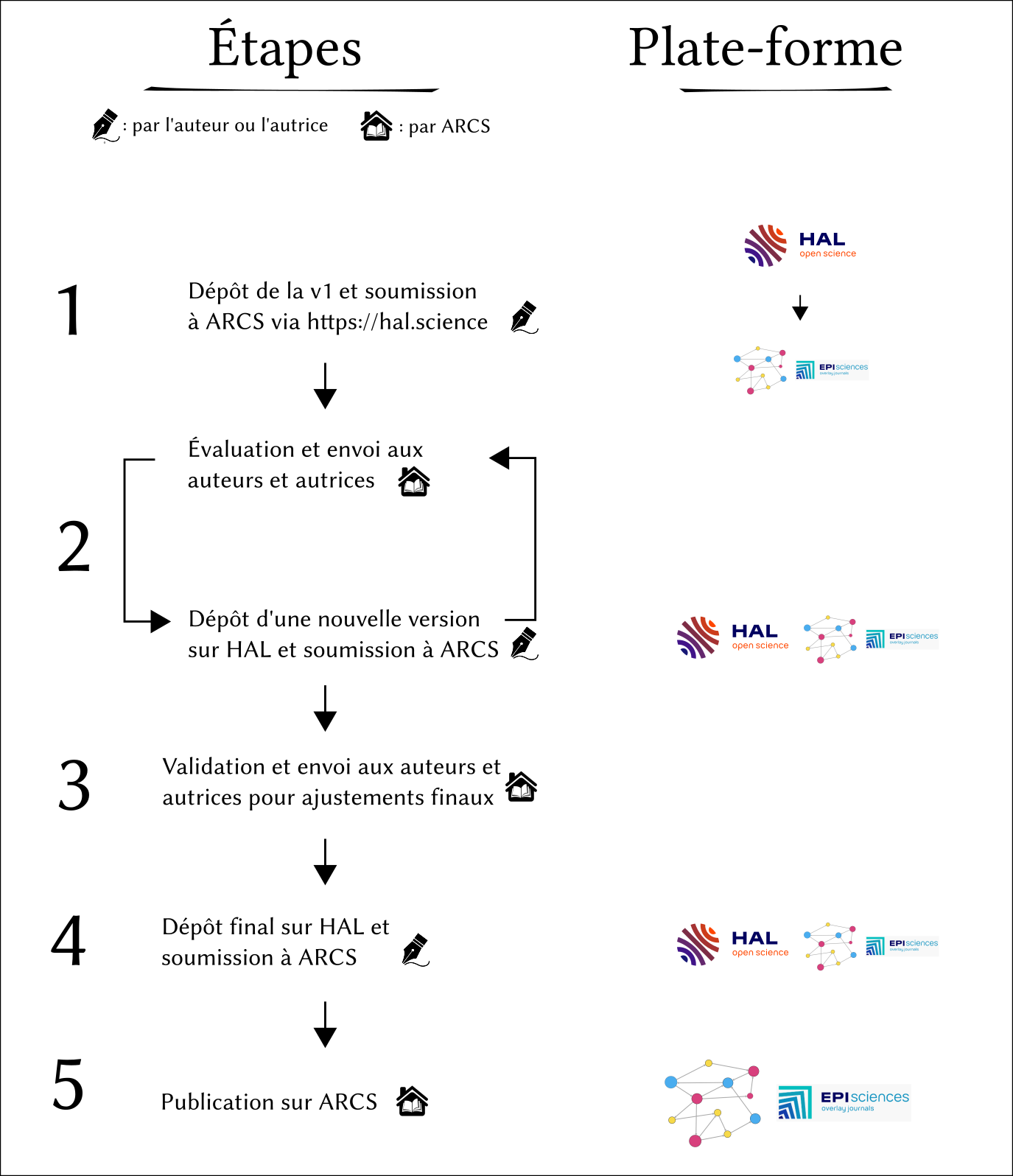 |
Consignes aux auteurs et autrices
La revue ARCS publie des articles inédits, en français ou en anglais, destinés à l’une ou l’autre des rubriques suivantes :
– Research papers/articles : articles présentant une recherche originale en SHS, soit mobilisant des méthodes d’analyse de réseaux, soit proposant une réflexion théorique et méthodologique sur l’analyse de réseaux en SHS ;
– Data papers : articles présentant la construction et l'intérêt thématique d'un jeu de données décrivant des relations (sous forme de listes de liens, matrices… ) dans un format standardisé, des métadonnées documentées et un DOI ;
– Software papers : présentation d'un outil, d'un logiciel, d'un package d'analyse de réseaux ;
– Comptes rendus : comptes rendus d'événements, d'ouvrages, de thèses etc. liés à l'analyse de réseaux ;
– Notes de recherche : texte court présentant une recherche projetée ou en cours;
– Traduction : la version traduite en français d'un article déjà publié dans une autre langue. La version traduite peut présenter quelques petits changements par rapport à la version originale. Ces changements ou ajouts doivent être mis en évidence (surlignés ou soulignés) dans la version soumise.
La longueur des articles est variable selon les rubriques : les articles de recherche ont une longueur maximum de 80 000 signes (espaces, notes de bas de page et références bibliographiques comprises), les autres articles ont un format plus court.
Si la proposition est rédigée en français, et notamment pour les articles, la revue souhaite un résumé long en anglais (1 page) indiquant la problématique, les données et méthodes ainsi que les principaux résultats. Ceci pourrait permettre à un lectorat non francophone de comprendre l'essentiel de l'article.
Les manuscrits soumis par l’auteur ou l'autrice ne doivent pas l’être en même temps à une autre publication. La revue ARCS utilise la norme APA pour les références bibliographiques.
La revue ARCS encourage l'écriture épicène, l'ouverture des données et le partage des scripts ayant permis d'obtenir les résultats publiés.
Comment soumettre un article ?
Déposer votre proposition sur HAL en tant que « pré-publication » (preprint). Attention : à ce stade, le nom de la revue ne doit apparaître ni dans les métadonnées du document, ni dans le contenu du document déposé. HAL permet de soumettre directement à la revue lors du dépôt (menu déroulant en bas de page).
En cas de nouvelle version (après évaluation), ajouter une version au dépôt initial dans HAL et ne pas créer un nouveau dépôt.
Si vous rencontrez des difficultés, vous pouvez nous solliciter à l'adresse arcs@episciences.org.
Si le dépôt HAL rencontre du retard, vous pouvez solliciter le service support de episciences à l'adresse : support@episciences.org
Évaluation
À la réception de l’article proposé, un accusé de réception électronique est envoyé à l’auteur.e.
Les articles sont évalués par 3 personnes, dont au moins 1 membre du comité de rédaction de la revue ARCS, et 1 expert.e extérieur.e désigné.e par les membres du comité de rédaction. Les évaluations sont anonymes – la liste de l’ensemble des expert⋅e⋅s extérieur⋅e⋅s ayant concouru à l’évaluation au cours d’une année civile est publiée dans la revue l’année suivante.
L’évaluation de l’article portera sur :
– son adéquation avec le domaine et les objectifs de la revue, ainsi qu’avec la rubrique pour laquelle il est proposé ;
– l’originalité du sujet traité ;
– la qualité de la démonstration d’ensemble ;
– la maîtrise de l’analyse des données ;
– la pertinence de la bibliographie ;
– la lisibilité du texte ;
– l’attention apportée aux annexes et plus généralement à la reproductibilité de la recherche (données en accès ouvert, scripts utilisées, grilles d'entretien ou d'observation, etc.).
Les traductions proposées feront l'objet d'une procédure d'évaluation allégée, limitée à une évaluation interne, par un⋅e membre du comité de rédaction, afin de garantir l'adéquation de l'article avec les thématiques d'ARCS ainsi que la correction du français.
Au vu des évaluations, le comité de rédaction de la revue statue sur l’acceptation ou le refus de l’article, en distinguant quatre niveaux de réponse différents :
– l’article est refusé ;
– l’article est refusé avec encouragement à soumettre une nouvelle version : le comité de rédaction fait connaître à l’auteur ou l'autrice les améliorations demandées, et iel dispose d’un délai de deux semaines pour faire connaître la suite qu’elle ou il entend donner à sa proposition. S’iel choisit d’entreprendre les améliorations, iel dispose ensuite d’un délai de deux à six mois pour soumettre la nouvelle version de l’article. La deuxième version de l’article est alors examinée par les personnes qui en avaient évalué la première version ;
– l’article est accepté sous réserve de corrections ou de modifications : le comité de rédaction fait connaître à l’auteur ou l'autrice les améliorations demandées. Iel dispose d’un délai de deux semaines à deux mois pour effectuer ces modifications, en fonction de leur importance ;
– l’article est accepté en l’état.
Lorsque des modifications sont demandées et si les évaluateurs et évaluatrices l’acceptent, la rédaction lève leur l’anonymat afin de permettre un dialogue constructif, sur le modèle de ce qui est réalisé notamment par la revue Nouvelles perspectives en sciences sociales.
